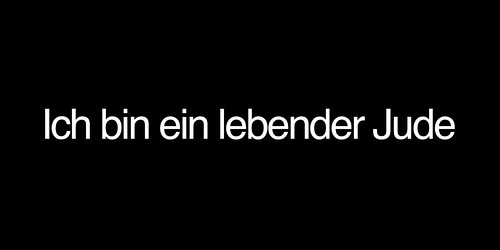have you been kiruv'd lately?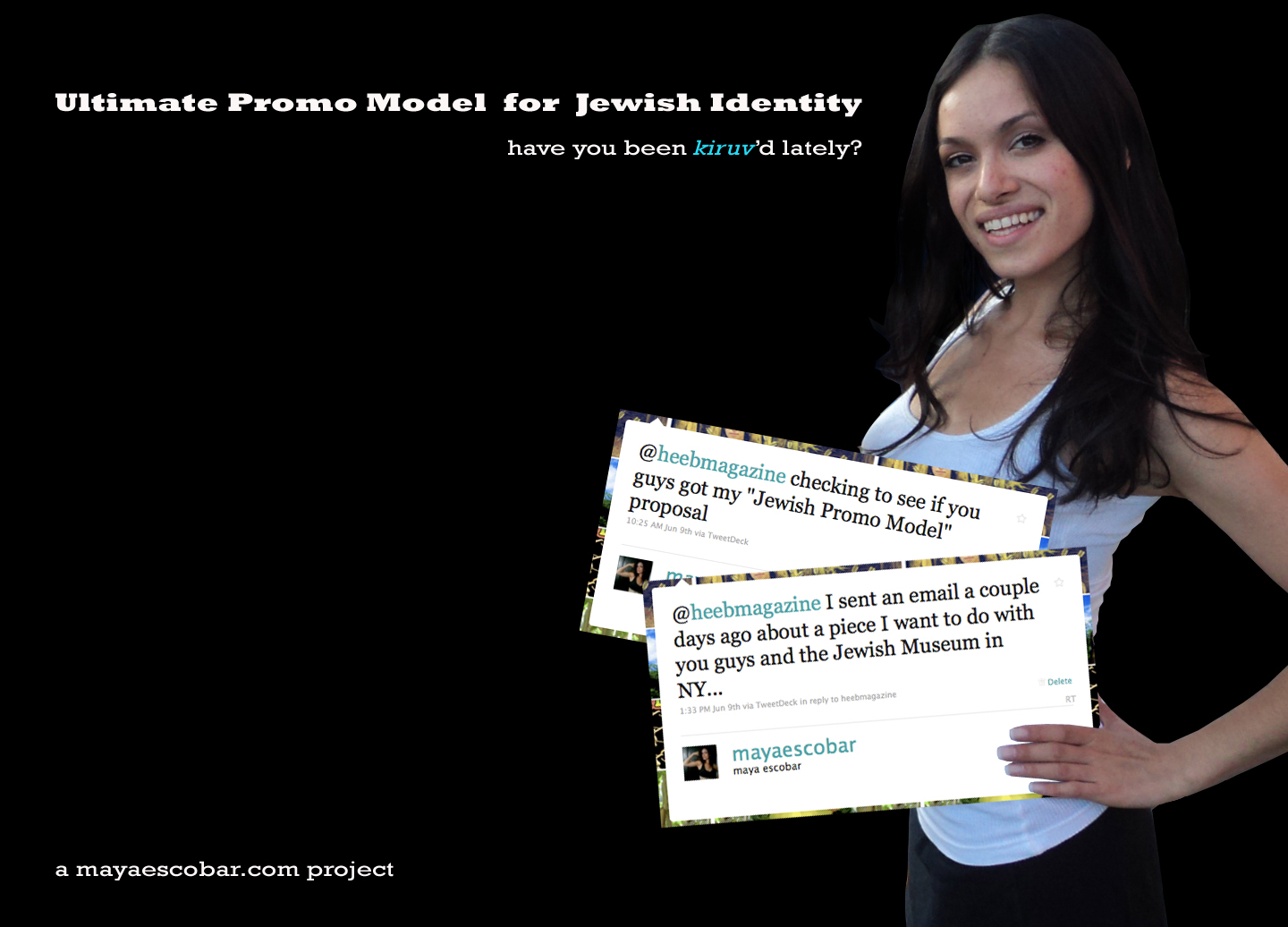
Blurring Boundaries Between Jewish Denominations
Excerpt from the Tzit Tzit: Fiber Art and Jewish Identity Exhibition Catalog, by curator Ben Schacter.
Maya Escobar is a Latina Jew who relishes her ability to blur the boundaries not only between cultures but Jewish denominations. Her Shomer Negiah Panites is an extreme example. The expression shomer negiah refers to the law that limits sexual relations. While a women is menstruating and for several days after, she is not allowed to touch her husband. At the end of this time, she takes a ritual bath called a mikvah. This monthly ritual balances abstinence, cleanliness and intimacy. It is said by those who follow this tradition that time together is made even more precious.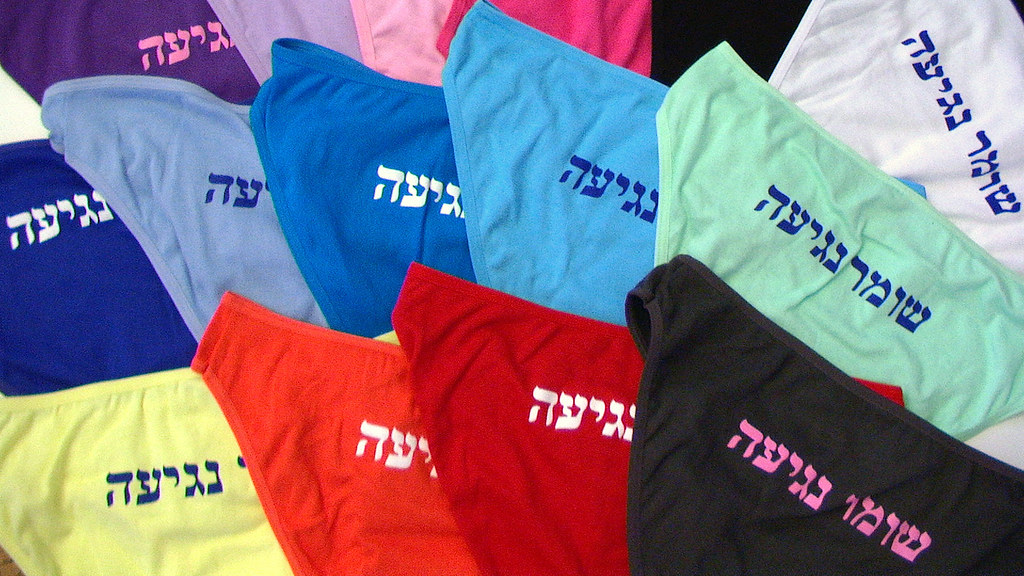 Shomer Negiah Panties, 2005Escobar’s work seems to turn this custom on its ear. First, sexuality in the Orthodox community is not publicly displayed. Underwear or anything remotely like it would not be shown in public. Second, part of the function of shomer negiah is one of modesty, not one to tease. But in a twist of modernity, the “tease” can be a way of female control. To exclaim, “Hands Off!” at precisely the moment of greatest vulnerability is exactly what Escobar’s underwear does.Heckshered Tallis presents an air of transgression without doing so. A hecksher is a stamp placed on food to certify that its ingredients and method of processing follows the dietary rules observed by many Jews, called Kashrut. The symbols themselves have nothing to do with prayer and do not belong on a tallis, or prayer shawl, but the obsessive imprimatur suggests an over compensation on the part of the wearer. Women are not required to wear such garments but some congregants of more liberal egalitarian congregations do. Is Escobar suggesting women’s insecurity by obsessively certifying this tallis as “Kosher?”
Shomer Negiah Panties, 2005Escobar’s work seems to turn this custom on its ear. First, sexuality in the Orthodox community is not publicly displayed. Underwear or anything remotely like it would not be shown in public. Second, part of the function of shomer negiah is one of modesty, not one to tease. But in a twist of modernity, the “tease” can be a way of female control. To exclaim, “Hands Off!” at precisely the moment of greatest vulnerability is exactly what Escobar’s underwear does.Heckshered Tallis presents an air of transgression without doing so. A hecksher is a stamp placed on food to certify that its ingredients and method of processing follows the dietary rules observed by many Jews, called Kashrut. The symbols themselves have nothing to do with prayer and do not belong on a tallis, or prayer shawl, but the obsessive imprimatur suggests an over compensation on the part of the wearer. Women are not required to wear such garments but some congregants of more liberal egalitarian congregations do. Is Escobar suggesting women’s insecurity by obsessively certifying this tallis as “Kosher?”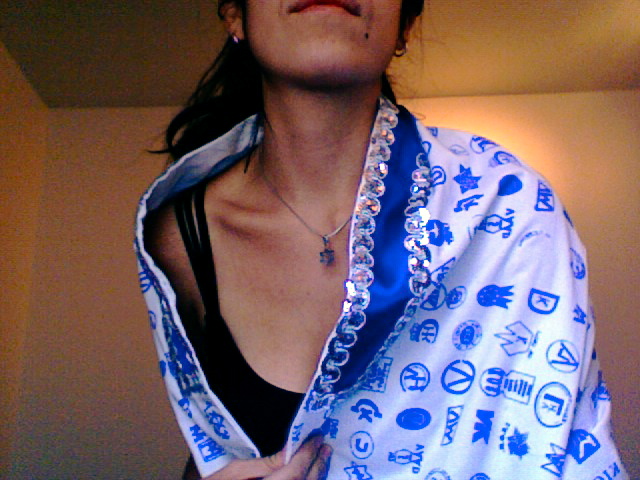 Kosher Davening, 2006The pattern of heckshers also creates a fashion akin to a Louis Vuitton print where the fabric is paradigmatic of luxury. Hechshered Tallis brings high fashion and religion together in a satisfyingly truthful and critical way. Even more interesting is the way Escobar’s work comments on different traditions and laws through fashion. Escobar’s oeuvre highlights denominational fragmentation by drawing attention to certain details of Jewish life. The traditional woman who follows shomer negiah would most likely not wear a tallis. Identity is rarely mixed in this way. For an artist to be able to make cross-denominational commentary such as found in Shomer Negiah Panties and Heckshered Tallis takes keen observation. Escobar does not exempt her own experience from such examination.As she shared with me, her family chided her to make napkins for her future, now husband. This traditional role, that is to make the home, chaffed her mildly. She was resistant to such commonplace assumptions about gender so to exaggerate the request, she embroidered “napkin for my husband” across hand woven fabric. Her actions as a wife would thus never be taken for granted.
Kosher Davening, 2006The pattern of heckshers also creates a fashion akin to a Louis Vuitton print where the fabric is paradigmatic of luxury. Hechshered Tallis brings high fashion and religion together in a satisfyingly truthful and critical way. Even more interesting is the way Escobar’s work comments on different traditions and laws through fashion. Escobar’s oeuvre highlights denominational fragmentation by drawing attention to certain details of Jewish life. The traditional woman who follows shomer negiah would most likely not wear a tallis. Identity is rarely mixed in this way. For an artist to be able to make cross-denominational commentary such as found in Shomer Negiah Panties and Heckshered Tallis takes keen observation. Escobar does not exempt her own experience from such examination.As she shared with me, her family chided her to make napkins for her future, now husband. This traditional role, that is to make the home, chaffed her mildly. She was resistant to such commonplace assumptions about gender so to exaggerate the request, she embroidered “napkin for my husband” across hand woven fabric. Her actions as a wife would thus never be taken for granted.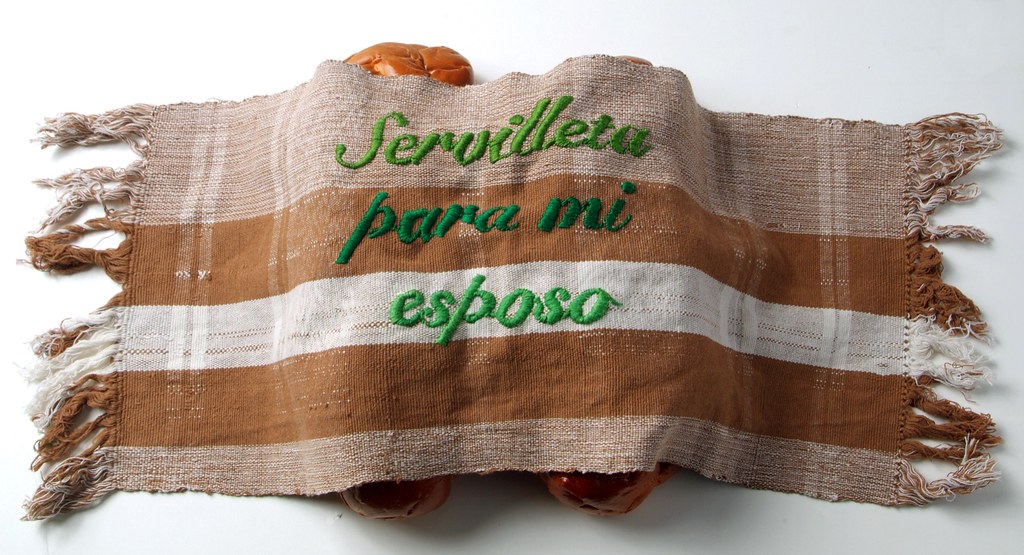 Napkin For My Husband, 2007Napkin has been given an additional function, as a challah cover. One covers the challah, or bread made specifically to honor the Sabbath, before the blessing is said and the bread is cut. To embellish a cover heightens the ritual by making the objects beautiful. Napkin tethers together Jewish practice and the work of a relationship. Through her demonstrated knowledge of Jewish custom in her work, one wonders if she also knows Eishet Hayil, a song sung in praise of one’s wife. “A good wife, who can find? She is precious far beyond rubies.” Perhaps Escobar is not so passive aggressively demanding to be serenaded.
Napkin For My Husband, 2007Napkin has been given an additional function, as a challah cover. One covers the challah, or bread made specifically to honor the Sabbath, before the blessing is said and the bread is cut. To embellish a cover heightens the ritual by making the objects beautiful. Napkin tethers together Jewish practice and the work of a relationship. Through her demonstrated knowledge of Jewish custom in her work, one wonders if she also knows Eishet Hayil, a song sung in praise of one’s wife. “A good wife, who can find? She is precious far beyond rubies.” Perhaps Escobar is not so passive aggressively demanding to be serenaded.
Tzit Tzit: Fiber Art and Jewish Identity
I met Ben Schachter at the 2009 Conney Conference on Jewish Art: Performing Histories, Inscribing Jewishness, where coincidentally, we both presented Eruv themed works.In addition to making humorous Jewish themed conceptual art, Ben is a curator and is the man behind Tzit Tzit: Fiber Art and Jewish Identity. I have a few pieces from Hiddur Mitzvah included in the show.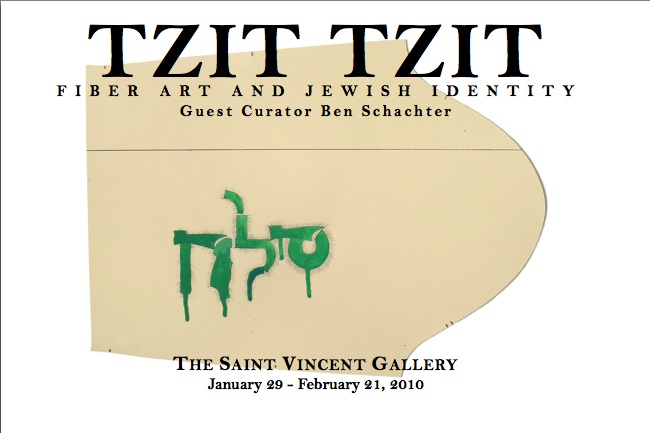 A special exhibit assembled by guest curator Ben Schachter, “Tzit Tzit: Fiber Art and Jewish Identity,” will open with a reception at The Saint Vincent Gallery in the Robert S. Carey Student Center at Saint Vincent College from 6 to 8:30 p.m. Thursday, January 28. Admission is free and open to the public.The exhibit will continue from Friday, January 29 through Sunday, February 21 during regular Gallery hours: 12 noon to 3 p.m. and 6:30 to 8:30 p.m. Tuesdays, Wednesdays and Thursdays; 12 noon to 3 p.m. Fridays, Saturdays and Sundays. The Gallery is closed on Mondays.Participating artists include Maya Escobar, Melanie Dankowicz, Carol Es, Leslie Golomb, Louise Silk and Shirah Apple.Ms. Silk will present a lecture, “Quilting and Spirituality,” at 6 p.m. Monday, February 9 in room 100 of Prep Hall.Mr. Schachter, associate professor of fine arts, will give a Gallery tour of the exhibition at 7:30 p.m. Tuesday, February 9.The exhibit was developed by Mr. Schachter. “I have been studying various aspects of Jewish art for the past three years and this exhibit is an outgrowth of that interest,” Mr. Schachter said. “The artists hail from Los Angeles, New York City, Kansas City, Illinois and Pittsburgh.”“Fiber art refers to any use of a cloth such as stitching or weaving,” he explained. “The title, Tzit Tzit, refers to the fringe on a prayer shawl, or tallis, worn by many Jews during prayer. While using thread, cloth, pattern making, stitching and other craft materials, each artists’ process creates a language derived from craft techniques that reinterprets the Old Testament, the oral law as written in the Talmud and personal histories. In so doing, both craft theory and Jewish Art are reinvigorated. I learned of these artists through Jewish art conferences I have attended, through exhibitions and through national awards. I think our students and our friends in the region will really enjoy seeing their work.”Ben Schachter is an artist whose work integrates conceptual art and Jewish law. He sees a connection between the rules artists have created to guide and limit their work and Jewish traditions. His work has been shown nationally and will be on exhibition at the Westmoreland Museum of Art in Greensburg concurrent with this exhibition. He holds an M.F.A. and M.S. degree from Pratt Institute and lives in Pittsburgh with his wife and two children.Carol Es paints images that powerfully scream of a life of hard labor. As a child she worked endless hours in a sweatshop with her family. Ms. Es' works are featured in numerous private and public collections, including the Getty Museum, Brooklyn Museum, UCLA Special Collections, the Jaffe Collection and Centre Georges Pompidou in Paris. She is also a two-time recipient of the ARC Grant from the Durfee Foundation and was recently awarded the prestigious Pollock-Krasner Fellowship.Maya Escobar’s work directly challenges gender roles and illustrates how Jewish tradition empowers women. Ms. Escobar received her master of fine arts degree from the Sam Fox School of Design & Visual Arts, Washington University in St. Louis, and her bachelor of fine arts degree from the School of the Art Institute of Chicago. She has exhibited work in Spain, Guatemala, United States, Germany and Venezuela.Melanie Dankowicz creates intricate papercut sculptures, marriage contracts, and wall art. An expansion of the medium, Dankowicz's three-dimensional forms are ephemeral lace-like paper structures, of elegant tracery that has inspired her recent metalwork. She draws inspiration from the countryside of Illinois, where she resides with Harry and their three children.Leslie Golomb exhibits her work nationally and internationally and is the recipient of numerous awards, including recognition from the National Endowment for the Arts, Pennsylvania Council on the Arts Individual Artists Fellowship Award and a State of the Art Award from the State Museum of Pennsylvania. Her work was recently included in the Three Rivers Arts Festival and Best of Pittsburgh Invitational. Ms. Golomb holds a bachelor in fine arts from Carnegie-Mellon University and a master of fine arts from the School of the Art Institute of Chicago. She served as founder and director of the American Jewish Museum of the Jewish Community Center of Greater Pittsburgh for nine years. She has returned to the studio producing prints and artists books.Louise Silk began her quest to acquire skills as a quilter after being inspired by an article in Ms. Magazine in 1971 about quilt making as a woman's art form. Over the past 30 years, her work has been included in Quilt National Biennial Exhibition of Contemporary Quilts as well as many private corporate collections such as USAirways, Paine Webber and PNC Bank. She is a certified Integrated Kabbalistic Healer. She is currently living and working from her loft in the South Side of Pittsburgh, Pennsylvania.Ms. Golumb and Ms. Silk collaborate and join their printmaking and fiber art into multilayered quilts, runners and tallisim. The images and techniques bring together American folk traditions and Jewish history in surprising ways. Ultimately the perspective of these five artists reinvigorates what Jewish Art is and can become.Shirah Apple received a master of fine arts degree from the Rinehart School of Sculpture at the Maryland Institute College of Art in 2006. She is a graduate of MICA’s post-baccalaureate certificate program and of Miami University, where she received a bachelor of science degree in business administration.Further information about the exhibition is available by contacting the Gallery at 724 805-2107, www.stvincent.edu/gallery.
A special exhibit assembled by guest curator Ben Schachter, “Tzit Tzit: Fiber Art and Jewish Identity,” will open with a reception at The Saint Vincent Gallery in the Robert S. Carey Student Center at Saint Vincent College from 6 to 8:30 p.m. Thursday, January 28. Admission is free and open to the public.The exhibit will continue from Friday, January 29 through Sunday, February 21 during regular Gallery hours: 12 noon to 3 p.m. and 6:30 to 8:30 p.m. Tuesdays, Wednesdays and Thursdays; 12 noon to 3 p.m. Fridays, Saturdays and Sundays. The Gallery is closed on Mondays.Participating artists include Maya Escobar, Melanie Dankowicz, Carol Es, Leslie Golomb, Louise Silk and Shirah Apple.Ms. Silk will present a lecture, “Quilting and Spirituality,” at 6 p.m. Monday, February 9 in room 100 of Prep Hall.Mr. Schachter, associate professor of fine arts, will give a Gallery tour of the exhibition at 7:30 p.m. Tuesday, February 9.The exhibit was developed by Mr. Schachter. “I have been studying various aspects of Jewish art for the past three years and this exhibit is an outgrowth of that interest,” Mr. Schachter said. “The artists hail from Los Angeles, New York City, Kansas City, Illinois and Pittsburgh.”“Fiber art refers to any use of a cloth such as stitching or weaving,” he explained. “The title, Tzit Tzit, refers to the fringe on a prayer shawl, or tallis, worn by many Jews during prayer. While using thread, cloth, pattern making, stitching and other craft materials, each artists’ process creates a language derived from craft techniques that reinterprets the Old Testament, the oral law as written in the Talmud and personal histories. In so doing, both craft theory and Jewish Art are reinvigorated. I learned of these artists through Jewish art conferences I have attended, through exhibitions and through national awards. I think our students and our friends in the region will really enjoy seeing their work.”Ben Schachter is an artist whose work integrates conceptual art and Jewish law. He sees a connection between the rules artists have created to guide and limit their work and Jewish traditions. His work has been shown nationally and will be on exhibition at the Westmoreland Museum of Art in Greensburg concurrent with this exhibition. He holds an M.F.A. and M.S. degree from Pratt Institute and lives in Pittsburgh with his wife and two children.Carol Es paints images that powerfully scream of a life of hard labor. As a child she worked endless hours in a sweatshop with her family. Ms. Es' works are featured in numerous private and public collections, including the Getty Museum, Brooklyn Museum, UCLA Special Collections, the Jaffe Collection and Centre Georges Pompidou in Paris. She is also a two-time recipient of the ARC Grant from the Durfee Foundation and was recently awarded the prestigious Pollock-Krasner Fellowship.Maya Escobar’s work directly challenges gender roles and illustrates how Jewish tradition empowers women. Ms. Escobar received her master of fine arts degree from the Sam Fox School of Design & Visual Arts, Washington University in St. Louis, and her bachelor of fine arts degree from the School of the Art Institute of Chicago. She has exhibited work in Spain, Guatemala, United States, Germany and Venezuela.Melanie Dankowicz creates intricate papercut sculptures, marriage contracts, and wall art. An expansion of the medium, Dankowicz's three-dimensional forms are ephemeral lace-like paper structures, of elegant tracery that has inspired her recent metalwork. She draws inspiration from the countryside of Illinois, where she resides with Harry and their three children.Leslie Golomb exhibits her work nationally and internationally and is the recipient of numerous awards, including recognition from the National Endowment for the Arts, Pennsylvania Council on the Arts Individual Artists Fellowship Award and a State of the Art Award from the State Museum of Pennsylvania. Her work was recently included in the Three Rivers Arts Festival and Best of Pittsburgh Invitational. Ms. Golomb holds a bachelor in fine arts from Carnegie-Mellon University and a master of fine arts from the School of the Art Institute of Chicago. She served as founder and director of the American Jewish Museum of the Jewish Community Center of Greater Pittsburgh for nine years. She has returned to the studio producing prints and artists books.Louise Silk began her quest to acquire skills as a quilter after being inspired by an article in Ms. Magazine in 1971 about quilt making as a woman's art form. Over the past 30 years, her work has been included in Quilt National Biennial Exhibition of Contemporary Quilts as well as many private corporate collections such as USAirways, Paine Webber and PNC Bank. She is a certified Integrated Kabbalistic Healer. She is currently living and working from her loft in the South Side of Pittsburgh, Pennsylvania.Ms. Golumb and Ms. Silk collaborate and join their printmaking and fiber art into multilayered quilts, runners and tallisim. The images and techniques bring together American folk traditions and Jewish history in surprising ways. Ultimately the perspective of these five artists reinvigorates what Jewish Art is and can become.Shirah Apple received a master of fine arts degree from the Rinehart School of Sculpture at the Maryland Institute College of Art in 2006. She is a graduate of MICA’s post-baccalaureate certificate program and of Miami University, where she received a bachelor of science degree in business administration.Further information about the exhibition is available by contacting the Gallery at 724 805-2107, www.stvincent.edu/gallery.
Berlin's Eruv Talk
I will be presenting Berlin's Eruv at KAM Isaiah Israel, as part of their World Jewry Program, this Sunday, November 8th. The lecture is open to the public.
 video still from interview with Moshe Or
video still from interview with Moshe Or
In 2008 I traveled to Berlin as part of exchange program with my University. Prior to this visit, I had never been to Germany- nor did I have any particular reservations about going or not going, but it seemed everyone else had their own opinion on the matter.“Germany, how can you go there as a Jew?” “There are Jews in Germany? I thought they were all dead?” “You are so brave to go to Germany…”Ultimately people’s projections as to my intentions for going to Germany became the filter through which I experienced Berlin.While I was in Berlin I conducted interviews with members of the community concerning the highly visible presence of the monuments and memorials commemorating Jewish life (death) have impacted their individual and communal Jewish identities. Other topics included: the notion of German Jews vs Jews living in Germany and how this differs from an American Jewish identity, their status as diaspora Jews and their relationship to Israel, their thoughts on the European Union, anti-semitism and the widespread use of facebook as a mode of connection.The title of the piece Berlin’s Eruv is a play on the fact that there is not actually an eruv in Berlin. An eruv is a rabbinically sanctioned demarcation of space that transforms public space into private space for the purposes of the Sabbath, allowing Orthodox Jews to carry in public places, a practice which is otherwise prohibited. Modern eruvs are often made of wire strung between utility poles, a gesture towards a “walled courtyard,” indicating an enclosed, private space.Just as the eruv exists in the minds of the people who abide by it, Berlin’s Eruv manifests itself through the conversations surrounding the idea of the piece. The interviews I conducted in Berlin relied on the presence of institutionalized markers of Jewish identity, to give weight to the idea non-presence of the living Jewish community.
Berlin's Eruv Talk
11/8/09 @ 10:30 amKAM Isaiah Israel1100 E Hyde Park BlvdChicago, IL 60615-2810773-924-1234
Berlin's Eruv
Fundraiser for the Teamster Reform Movement
Jewish Identity Questions- generated by the 2008 Jewish Multiracial Network Retreat Youth Staff with Artist Maya Escobar
I just returned from the residency I did for the Jewish Multiracial Network, located at Isabella Freedman Jewish Retreat Center. As part of my programming I worked with the youth staff to generate a series of questions regarding Jewish Identity. These questions then set the framework for the theater games (inspired by theater of the oppressed) and the flag books that we made over the course of the weekend.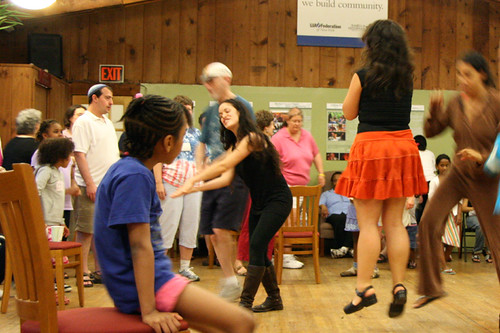 Unfortunately not everyone got around to answering these questions at the retreat, however here is a new chance :). So I now invite anyone and everyone to participate in finding answers to these questions (JMNners, non-JMNers, Jews, non-Jews..... )What do you need from society, yourself, the Jewish Community to recognize diversity and to become aware of racism, sexism, homophobia (oppression) both internalized and experienced and the times you yourself have been racist, sexist , homophobic, and then move past to create change?What do you do when you are in an uncomfortable situation regarding your Judaism?Do you have a Non-Jewish side, what is that like?What makes a person culturally Jewish?What make you a Jew in your everyday life?Define what makes someone Jewish.Name your greatest Jewish moment.Why are you Jewish?What does a Jew look like?Did you ever not feel Jewish?What is it about being Jewish that makes you most proud?What do you love about being Jewish?What was your weirdest Jewish Experience?Have you ever questioned your Jewish Identity?Has anyone else ever questioned your Jewish Identity?Have you ever questioned another persons Jewish Identity?What symbols represent Judaism for you?What non-Jewish activities do you partake in that to you are “Very Jewish”?What is your responsibility as a Jew of color?What is your responsibility as a Jew?
Unfortunately not everyone got around to answering these questions at the retreat, however here is a new chance :). So I now invite anyone and everyone to participate in finding answers to these questions (JMNners, non-JMNers, Jews, non-Jews..... )What do you need from society, yourself, the Jewish Community to recognize diversity and to become aware of racism, sexism, homophobia (oppression) both internalized and experienced and the times you yourself have been racist, sexist , homophobic, and then move past to create change?What do you do when you are in an uncomfortable situation regarding your Judaism?Do you have a Non-Jewish side, what is that like?What makes a person culturally Jewish?What make you a Jew in your everyday life?Define what makes someone Jewish.Name your greatest Jewish moment.Why are you Jewish?What does a Jew look like?Did you ever not feel Jewish?What is it about being Jewish that makes you most proud?What do you love about being Jewish?What was your weirdest Jewish Experience?Have you ever questioned your Jewish Identity?Has anyone else ever questioned your Jewish Identity?Have you ever questioned another persons Jewish Identity?What symbols represent Judaism for you?What non-Jewish activities do you partake in that to you are “Very Jewish”?What is your responsibility as a Jew of color?What is your responsibility as a Jew?
caminante no hay camino
 There is one specific image that I have never been able to remove from my mind: an image of a Guatemalan solider pointing a gun at the belly of a young pregnant woman. Ironically, I have no recollection as to the source of that specific image. Part of me wonders if that image even existed, or if it was a confabulation of my youth, created in response to the countless stories of political massacre in Guatemala that my father described to me on a regular basis.The Power of ImageRecently I attended a symposium on Architecture, Art and the Experience of Blackness, where I was greatly moved by the words of Hamza Walker, who serves as the Director of Education and Associate Curator for the Renaissance Society at the University of Chicago.In an effort to outline “blackness” or the “black experience”, Walker alluded to the profound impact of the publication of the casket-side Emmett Till photos in JET magazine.The Till incident began with the brutal beating and murder of an 11yr old boy, whose only crime was whistling at a white woman. In a surprisingly high profile trial the two men accused were almost immediately acquitted by an all white jury. The boy’s grieving mother insisted on an open casket funeral so that the world could see what had happened to her beloved son.Walker said, that the media transmission of these transgressions confirmed the collective understanding shared by African Americans that this treatment was the reality of the judicial system. If they were to ever “compromise the integrity of a white woman” what happened to Till would happen to them.Is exposure to explicit images of human brutality the proper way to insure that these incidents do not repeat themselves?How many times have we seen the same iconographic holocaust pictures?But do we know who is in these images and what is taking place?Has seeing the same images a million times done anything the stop the Iraq war or prevent genocide in Darfur?Perhaps the issue comes down to the dissemination of information to young people. Without providing a proper context for the interpretation and dialogue surrounding these explicit images, the depicted incidents become far removed from our lives, and we become numb to their reality.Why a Coloring Book?Coloring Books, emerged in the United States a part of the movement towards the “democratization of education”. They are commonly utilized in popular education models as, accessible teaching tools for often illiterate audiences.This coloring book provides the platform for the introduction and the critical re-evaluation of social movements the context in which they occurred, and the individuals who have preserved and made a major impacts upon the world.
There is one specific image that I have never been able to remove from my mind: an image of a Guatemalan solider pointing a gun at the belly of a young pregnant woman. Ironically, I have no recollection as to the source of that specific image. Part of me wonders if that image even existed, or if it was a confabulation of my youth, created in response to the countless stories of political massacre in Guatemala that my father described to me on a regular basis.The Power of ImageRecently I attended a symposium on Architecture, Art and the Experience of Blackness, where I was greatly moved by the words of Hamza Walker, who serves as the Director of Education and Associate Curator for the Renaissance Society at the University of Chicago.In an effort to outline “blackness” or the “black experience”, Walker alluded to the profound impact of the publication of the casket-side Emmett Till photos in JET magazine.The Till incident began with the brutal beating and murder of an 11yr old boy, whose only crime was whistling at a white woman. In a surprisingly high profile trial the two men accused were almost immediately acquitted by an all white jury. The boy’s grieving mother insisted on an open casket funeral so that the world could see what had happened to her beloved son.Walker said, that the media transmission of these transgressions confirmed the collective understanding shared by African Americans that this treatment was the reality of the judicial system. If they were to ever “compromise the integrity of a white woman” what happened to Till would happen to them.Is exposure to explicit images of human brutality the proper way to insure that these incidents do not repeat themselves?How many times have we seen the same iconographic holocaust pictures?But do we know who is in these images and what is taking place?Has seeing the same images a million times done anything the stop the Iraq war or prevent genocide in Darfur?Perhaps the issue comes down to the dissemination of information to young people. Without providing a proper context for the interpretation and dialogue surrounding these explicit images, the depicted incidents become far removed from our lives, and we become numb to their reality.Why a Coloring Book?Coloring Books, emerged in the United States a part of the movement towards the “democratization of education”. They are commonly utilized in popular education models as, accessible teaching tools for often illiterate audiences.This coloring book provides the platform for the introduction and the critical re-evaluation of social movements the context in which they occurred, and the individuals who have preserved and made a major impacts upon the world.
video reel
[youtube=http://www.youtube.com/watch?v=3li_mT--f-A&hl=en]
Joanna Angel: Jews & Tattoos
[youtube=http://www.youtube.com/watch?v=f9laK9l_lq0&hl=en]
- Adult film superstar Joanna Angel pokes holes at the myth that Jewish faith won't allow you to go to heaven if you have tattoos -- and Joanna's got quite a few -- during the Wild Ass Circus' trip to Las Vegas for the 2008 AVN Awards
The Cuentos Foundation
I just submitted the work of Michele Feder-Nadoff, to the magazine I work for Zeek. Michele is a dear friend and a phenomenal artist, activist and educator. I thought it would be a good idea to share some information about Michele and to promote her organization the cuentos foundation.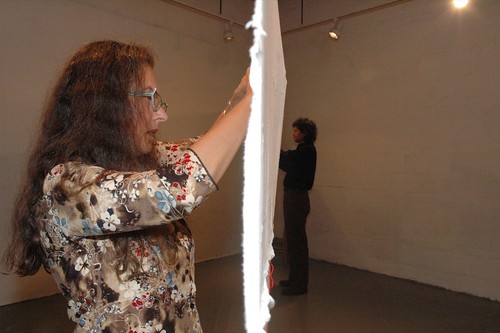 Artistic Director, Michele Feder-Nadoff, who is Jewish, founded Cuentos in 1998 with the humanist vision and commitment to tikkun haolam, a Jewish principal expressing each person’s responsibility to play a part in "healing the world." Cuentos members believe art is a transformative catalyst for effecting positive social change. Our work combats prejudice and discrimination through artistic and educational intergenerational projects and programs promoting mutual understanding.The abundance of cultural wealth living doorstep to doorstep in our neighborhoods provide all of us an opportunity to engage with and learn about each others' backgrounds. What connects us and how can live in peace together, connected by mutual understanding and appreciation of different cultures from around the globe?
Artistic Director, Michele Feder-Nadoff, who is Jewish, founded Cuentos in 1998 with the humanist vision and commitment to tikkun haolam, a Jewish principal expressing each person’s responsibility to play a part in "healing the world." Cuentos members believe art is a transformative catalyst for effecting positive social change. Our work combats prejudice and discrimination through artistic and educational intergenerational projects and programs promoting mutual understanding.The abundance of cultural wealth living doorstep to doorstep in our neighborhoods provide all of us an opportunity to engage with and learn about each others' backgrounds. What connects us and how can live in peace together, connected by mutual understanding and appreciation of different cultures from around the globe?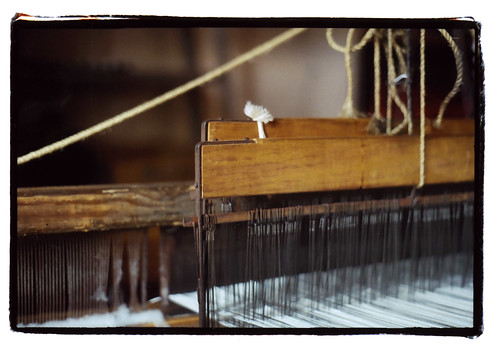
|
check out their new book: Ritmo de Fuego
Ritmo del Fuego / Rhythm of Fire is a unique achievement, telling the story of the deep-seated copperworking tradition of Santa Clara del Cobre, an ancient community in the forested mountains of Michoacán, Mexico. What is often seen as “folk art” is shown to stem from early workshops established in Michoacán during the 8th-9th centuries AD, by coastal traders and artisans from the Andean Region of South America. Since then, the manufactures have included utilitarian and ornamental objects. Many have been recovered at archaeological sites, most notably from the 15th century Tarascan Kingdom. Others embrace forms of Spanish origin after the 16th century conquest. Today in the expanding international market, Santa Clara copperwares include a wide range of sophisticated decorative vases, pitchers, trays, dinner wares and related forms. A vital community has evolved with this ongoing tradition, portrayed with affection and care by the project organizer Michele Feder-Nadoff, and the many other authors in this remarkable, well written contribution to the cultural history of the Americas.
click here to purchase
Maya Escobar isn't even Jewish
UPDATE: PHOTOS
 On an almost daily basis, I receive emails from people asking if I am in fact actually Jewish. Although I do find it somewhat bizarre that they find satisfaction in my acknowledgment of what I have already stated numerous times, I usually respond. Come to think of it, the occasions where I have been accepted as a Jew (without further questioning) have been few and far between.
On an almost daily basis, I receive emails from people asking if I am in fact actually Jewish. Although I do find it somewhat bizarre that they find satisfaction in my acknowledgment of what I have already stated numerous times, I usually respond. Come to think of it, the occasions where I have been accepted as a Jew (without further questioning) have been few and far between.
- “ No you can’t be Jewish you are Hispanic”
- “You don’t look Jewish”
- “Escobar… is that a Sephardic name?”
Recently I discovered that without our knowledge, the validity of my own and my brother Gonzalo’s Jewishness has come into question (to the point where documentation has been requested) from people that we are now very close with.Below are some of the examples of comments (not emails, I do not share the content of emails without permission) from youtube:
roundedwhtcollar Am I the only one who thinks this reprobate Turd is NOT in fact a Jew? Rafaelpicc But is her las name jewish? or converted? ReptorY her last name isnt jewish. xruchy you are not jewish i guess... tus videos= cero aporte raquelita40 she's half Jewish/ half Guatemalan.nakedjanet i am also suspicious. for one thing, escobar is not a typical Jewish name. For another, Jewish girls are usually a whole lot smarter, and have a whole lot more substance, than this girl has
(from chaptzem blogspot) There is no way she is Jewish- there may be a small chance her family are anusim or something.But what gets even more bizarre is that interspersed with in those comments are horrible anti-semitic statements:
johnnycastle86xx all the jews have to die, stupid jewish puta de mierda. Que mierda que Hitler no mato a tu familia, asi tu no hubieras nacido. muerte a los judios y muerte a israel. mocrostyle3600 AnotherJewish nasty bitchmrrimfire She's an ugly cockroachfilet there's a nice Jewishcrew- club... Its re-open and called Auschwitz. the drinks are on the house!!! but only for jewish people roshanpinto13 i want to put you in a concentration camp bitch if your people want israel so bad why don’t you go there and rid the world from your hideous jewish ways
So in light of my sarcasric sense of humor I entitled this post : Maya Escobar isn’t even Jewish I wonder what will come of that statement... From Judaism 101: Who Is a Jew?
First, traditional Judaism maintains that a person is a Jew if his mother is a Jew, regardless of who his father is. The liberal movements, on the other hand, consider a person to be Jewish if either of his parents was Jewish and the child was raised Jewish. Thus, if the child of a Jewish father and a Christian mother is raised Jewish, the child is a Jew according to the Reform movement, but not according to the Orthodox movement. On the other hand, if the child of a Christian father and a Jewish mother is not raised Jewish, the child is a Jew according to the Orthodox movement, but not according to the Reform movement! The matter becomes even more complicated, because the status of that children's children also comes into question.
In my case my mother is Jewish and my father is not. Yet it is my father that pushed me to go to Hebrew school until I was 16. Rain or shine my parents have been attending Shabbat services at JRC for almost 20 years. I remember being so mad as a child that my friends got to go out on Friday nights, and I was stuck with my family not even allowed to watch TV when we got home from services. Vickie Korey left the nicest comment on my Rabbi Brant Rosen’s blog:
I remember Maya at Friday night services at JRC, sometimes listening intently, sometimes reading, but always being present. When one of the children of our extended spiritual family grows to be such a fine, thoughtful and accomplished young woman we are all proud. Gonzolo and Tina have worked hard to set a strong foundation for Maya and I am so pleased for her and her family.
A few months ago I met with my Rabbi to discuss my (art) work. During our discussion I mentioned to him how my father is feeling really nervous about me having an orthodox wedding where he will not be included in the ceremony. Brant said something to me that really touched my heart. Your father is the essence of what a Jew is, he is a stranger in a strange land. I agree with him whole-heartedly, and if you ask most JRC members I am sure they would agree as well. However that does not change the fact that he is not considered to be Jewish by our neighbors, and even if he converted, to them it would not be halakhic unless he went through orthodox conversion. So who is a Jew? Who determines this?As I stated in a previous post I will be working as the art director this summer for Camp JRF. I am in the process of creating this summer’s curriculum that will be geared towards answering these very questions and challenging notions of Jewish Identity. Below is a very rough sketch of my plan…. (Please let me know if you have any suggestions, or would be interested in contributing any resources) The Changing Face of Jewish Identity: an exploration of self and what it means to be a Jew in our contemporary societyTo introduce the concept of a changing Jewish Identity will discuss the following:
- How do we define ourselves/ how do others define us?
- Who is a Jew?
- Can someone be more or less Jewish/ who decides this?
- What is our role in society?
- What characteristics make up a Jew?
Mediums Mixed media sculpture Art Exhibitions The Jewish Identity Project Too Jewish Challenging Tradition Identities Written Works by Ilan Stavans Achy Obejas Rebecca Walker Campers will produce mixed media sculptures that reflect their perception of what it means to be a JewPre- Activities:
- We will begin as an ice breaker/ intro to project identifying the characteristics that make up Jews.
- Followed by a discussion on contemporary representations of Jews in Popular culture
Project Campers working in groups of 3-4 will have the option of creating either abstract or representational mixed media sculptures that to them represent Jewish identity. Prior to the construction of their piece students will need to create a (flexible) proposal that outlines their piece.
- Will it be site specific (interact with a certain location)?
- What form will it take?
- Will it have a function?
- What materials will be used based on the above?
If they end up going with more representational sculptures I thought it would be really cool to photograph the sculptures and to place them in various Jewish settings and non-Jewish settings (baseball stadium, temple, Shabbat dinner, work, school....)

